Bosnia and Herzegovina – Fed. Bosnia (Sarajevo, Tuzla, Zenica) May 12-13, 2019
Observations on Bosnia and Herzegovina.
1. Buy gas in Montenegro at €1.15/litre compared to an average of €1.26 in B&H.
2. Museum and church costs. This is the first country where I have had to pay to enter mosques and orthodox churches (only in Sarajevo). And the museums are relatively expensive compared to other places – averaging €5
3. B&H and especially Sarajevo is a parking nightmare. This is universal in any city without bicycles or motorcycles – both significantly reduce traffic and parking pressure. Most parking is in lots with barriers or manned street parking. I parked on a lot of sidewalks.
4. Roads are generally good but there are few 4-lane divided highways and a lot of mountains, especially in the south, west and east. Most of the potholes have been patched. The drivers in this country are unusually very cautious, drive slowly and don’t pass aggressively. It makes for slow driving.
5. Currency. May 2019: 1€ = 1.96 BAM – Bosnia Convertible Marka.
The road that follows the Tara River after the Montenegro border was a piece of crap, very narrow, full of potholes and patched pavement. Pass multiple rafting resorts. Highway M18 improves some and is lovely for the slow drive to Sarajevo as you pass through several gorges and rushing rivers.
Of the 4,2777,000 people in the country, 2.2 million were displaced during the war. !.2 million eventually emigrated to 25 different countries leaving the post-war population at 3.4 million.
In August 1995, NATO started air strikes on Serbian forces.
Roman Bridge. About 5kms SW of the city, this 5-pier bridge is completely intact but is not used. A 100m section of elevated road leads up to one side. Free
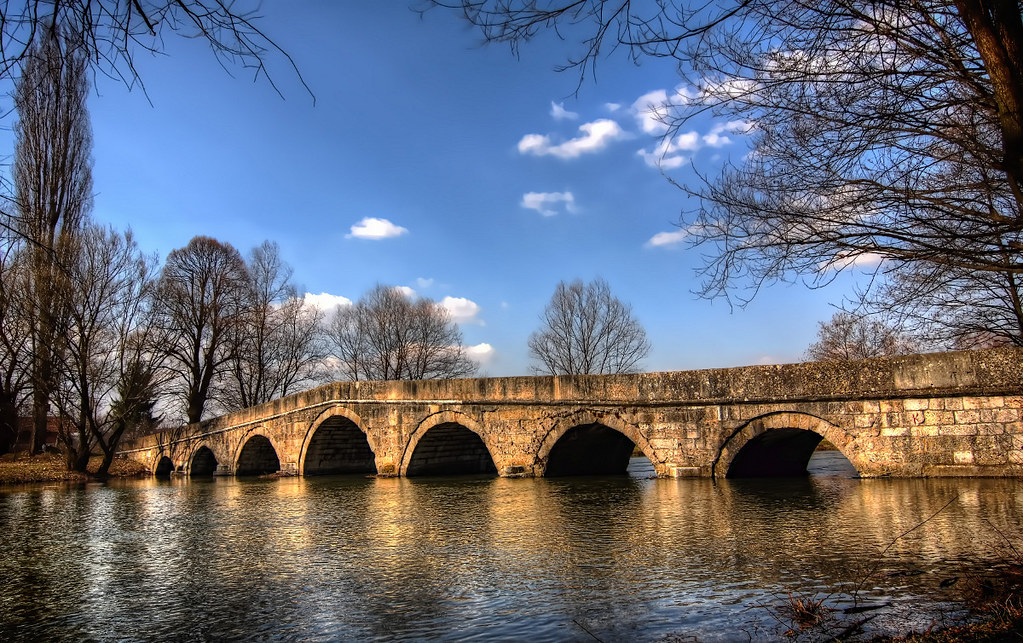
SARAJEVO
Sarajevo – unique symbol of universal multiculture – continual open city (N.I.) is a tentative WHS: (01/09/1997). Famous for the 1984 Olympics and the Bosnian war, it sits surrounded by low mountains.
In a referendum boycotted by the Bosnian Serbs in March 1992, the citizens voted 60% to leave the Yugoslav republic. On the next day, the JNA (Yugoslav People’s Army composed of Bosnian Serbs and Serbia laid siege to Sarajevo. Lasting 1,425 days until 1995, they invaded parts of the city and shelled it from batteries surrounding the city. An average of 330 shells/day rained onto the streets and buildings killing 11,541 people (1,601 children) and injuring 50,000. On July 22, 1993, the record 3,707 shells were shot. 400 explosion scars were painted with a red resin and called Sarajevo roses – a few of these still exist.
The city was completely blockaded (humanitarian supplies by road, water, food, electricity, and fuel) except for a United Nations-controlled area at the Sarajevo Airport. 20-25 humanitarian flights conducted by the UN starting in July 1992 brought in 90% of all supplies with 10 tons of goods arriving daily by plane.
The Serbs targeted all communication services (4 TV towers, newspaper offices), hospitals (55% destroyed), symbols of the city (the Olympic facilities; 2 million books in the library were destroyed) and schools. White phosphorus shells were used to start fires. Snipers from the hills controlled all major intersections – initially, they shot to kill but then changed their tactics to only injure. Mines were placed everywhere. Smuggled cigarettes became the main currency. Basic items like stoves and lighting were handmade showing great ingenuity. Human dynamos (bicycles connected to batteries) supplied much of the power. Most of the trees in the city were cut down for fuel. The sterilizer in the hospital was an antique burning wood.
In the first 2 months of the war, convoys carried mostly children and women out to of the city. The Dayton Peace Accord (signed in Dayton Ohio) ended the war on November 14, 1995. The total economic cost of the war was almost 14 billion US$.
The museum is in the Kolar house and shows artifacts pertinent to the tunnel. Watch 3 videos first to get a vivid picture of the city and tunnel. The preserved tunnel is only 25 metres long. 10 BAM (euros were not accepted but they allowed me to deposit my €5 into a charity box and enter).
Sarajevo War Tunnel. As the only way into the city was across the Airport runway, this was a target of snipers and very dangerous. As a result, a tunnel was built to move supplies into the city and became the main reason the city survived. It carried fuel lines, electricity cables and phone lines. It was originally 800m long, 1m wide and 1.6m high and crossed under the airport runway between the Kolar and Sloboda family houses on either side. It took over 3 months to build in 1993. Ventilation was an issue. In 994, tracks were laid so that supplies and injured could be carried in carriages. The tunnel was constantly flooded and rubber boots were necessary. It was open for 2 hours alternately each way. After the tunnel was a long trench from the Sloboda house into the city.
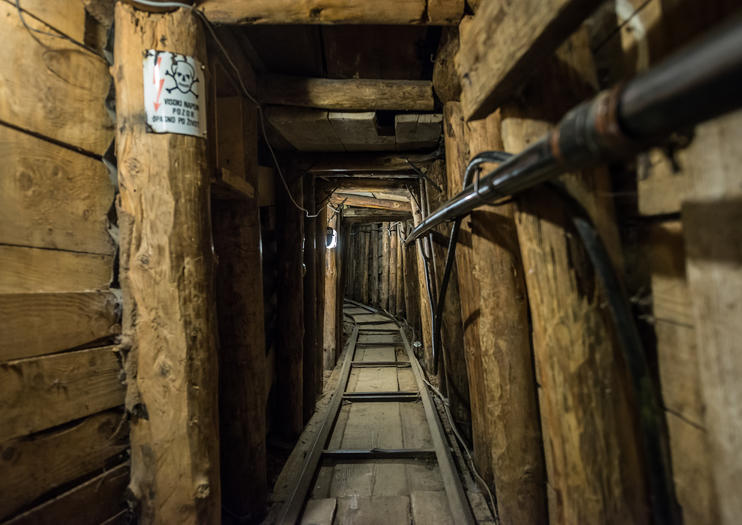
Alija Izetbegovic Museum. This museum is dedicated to Alija Izetbegović, the first president of an independent Bosnia and Herzegovina. The museum is housed in the old city gates, Ploča and Širokac, which are remnants of the old fortified city, Vratnik, that was built in the 18th century.
Not far from the museum is the memorial to martyrs in Kovači, with the mausoleum and last resting place of their wartime commander, Alija Izetbegović, which lies among the graves of the defenders of Sarajevo.
The entrance to the museum is located in Ploča Gate, which houses a library of Alija’s works, as well as a few of his personal items. Visitors can also watch the films, The Audacity of Living and In the Service of Bosnia, which talk about the first president. Up on the first floor there are nine exhibit panels which tell the story of Alija’s life through texts and photographs and the central part of this space displays the many awards and recognitions that he received.
There is an enclosed passage that runs between Ploča Gate and Širokac Gate and the latter houses an exhibit dedicated to Alija Izetbegović in his role as Commander of the Army of the Republic of Bosnia and Herzegovina. 8 BAM
Historical Museum of Bosnia and Herzegovina. This has one large room with details of the war and several artifacts (makeshift stoves, lighting, guns), photographs and newspaper articles. The ‘Art Lab’ has paintings and one wall is covered with before and after pictures of the war. 20 women are profiles with personal stories of how the war affected them. 6 BAM
National Museum of Bosnia and Herzegovina. In three buildings, this has Roman, ethnographic and natural history (fossils, stuffed animals in fair dioramas). 10KM 3 reduced.
Ars Aevi (Museum of Contemporary Art Sarajevo. Like almost all contemporary art museums, there is little of interest here. 6 BAM
Ali Pasha’s Mosque. Built in 1561, this limestone block mosque has 3 domes and carved stucco domes in the portico. It was closed and doesn’t appear to be open. The graveyard has some ancient stones – rectangular columns with great ‘turbans’ on top.
Avaz Twist Tower. This is a 176 m tall skyscraper in Sarajevo, the headquarters for Dnevni avaz, a Bosnian newspaper company. The tower is located in the Marijin Dvor city neighbourhood, Sarajevo’s central municipality. Construction began in 2006 and was finished two years later in 2008. The tower is notable for its twisted facade. It is currently the tallest skyscraper in the former Yugoslavia. In 2009, the famous German company Schüco chose the tower amongst the 10 most beautiful buildings in the world.
Backed by a concrete column, this business tower has a twisting blue glass façade. Take the elevator 31 floors up to the coffee bar and then step up to the viewpoint for 2 BAM. There are several shops and businesses on the ground floor.

Sarajevo Museum 1878-1912. At the 1878 Berlin Congress, the Austro-Hungarian monarchy got the mandate to occupy B&H. Resistance started and 14,000 Austro-Hungarian troops attacked on July 29, 1878, defeating all resistance in one day. Brick, tobacco, carpet, weaving, crafts, brewery, flour and sawmills were opened in the country over the next 30 years. The original trams were drawn by horses until 1895 when electricity arrived. Archduke Franc Ferdinand and his wife Sophia visited Sarajevo in 1914. Two assignment attempts were made on June 28, 1913. The first 2 bombs were thrown at their car unsuccessfully. Then both were shot dead by a single assassin. This event led to a chain of events that eventually triggered WW I. This tiny, one-room museum has some history and many personal artifacts. A touchscreen gives much-improved information along with several slide shows. 3 BAM
Bezistan Gazi Husrev-bey. A caravanserai named Taslihan was constructed next to this shopping mall in 1543 (vaults and domes made of lead, 2 floors the bottom for stables and storage and the top with 30 heated rooms for 90 guests), the victim of several fires, the last in 1879, it is now a ruin. The next year, this shopping mall was constructed next door. It is a lovely 200m long brick, barrel-vaulted corridor with 20 small barrel-vaulted shops on each side. It has an amazing number of handbag stores. The back opens up onto a long pedestrianized shopping street.
Gazi Husrev-beg Mosque. Surrounded by stone walls, this large mosque has a portico with 5 domes and a stone minaret. It is only open to tourists from 9-12 and 5:30-9. Across the lane is a museum on Gazi Husrev-beg, that appears to be built in an old madrassa. The mosque inside is very average and not worth the 3KM entrance fee (the front door is locked outside of prayer times but can be entered via a door just behind the minaret). There are some large stalactites in the front corners of the mosque.
Svrzo’s House (Svrzina House). Built in 1640 by the wealthy Glodar family, it is a typical Ottoman house of the 18th century (destroyed by fire in 1697 and reconstructed in the 18th century. It has two parts, a private haremluk for the family and a semanluk for the reception of male guests, service rooms and quarters for the domestic help. 10 BAM
War Childhood Museum. A book was written using Facebook research and 50 of the “stories” accompanied by personal objects are shown in lovely small vignettes. Six Syrian children also are included. A 30-minute video shows the personal stories of many who endured the war. 10 BAM
Jewish Museum (Muzej Jevreja). About 30 Jewish merchants arrived in Sarajevo in 1551, all Sephardic Jews originally from Spain and Portugal (who expelled all Jews between 1492 and 96. In 1070, there were 1,070 Jews in the city and all other Jewish communities in B&H were founded by Sarajevo Jews. A fire destroyed the synagogue in 1697 and 1788, it was ransacked and demolished in 1941 and was used as a prison for Jews by the Nazis (restored in 1957) and damage from the Balkan war was repaired in 2003. Since 2001, Rosh Hashanah has been celebrated here. Jews were not treated as full citizens of the city having to pay special taxes until 1856 when laws changed to make them equal to Muslims.
The museum is located in the former synagogue originally built in 1581. It is a lovely stone building with aisles on both sides and three domes. Two floors have been constructed to hold the museum exhibits chronicling Jewish contributions to the community along with several artifacts. 3 BAM
Museum of Crimes Against Humanity and Genocide. This tells the personal testimonials and major events in the Bosnian War of 1992-95 concentrating on torture, jailing, concentration camps, genocide, serial rape and all the horrific atrocities committed by the Serbs. There are many personal items very much like the War Childhood Museum. When mass graves were exhumed, often the only way to identify bodies was by the jewelry remaining on the bodies. 10 BAM
Gallery 11/07/1995. On the third floor of a building next to the cathedral, this museum primarily highlights the Srebrenica Genocide (a map of the genocide and a memorial film) when 8,000 men were murdered by Serbian militants over 3 days starting on July 11, 1995. The UN established a “safe” zone in Srebrenica in 1993 but didn’t defend it and only facilitated a concentration of people that made an easy target. The Siege of Sarajevo is also chronicled. Other exhibits include a video by Bill Clinton, a missing person’s wall, a portrait room and original posters created during the siege of Sarajevo. 12 BAM
Sacred Heart Cathedral. This lovely Roman Catholic church is painted inside into faux stone blocks in yellow and brown – on the walls, arches and columns. Free
Pijaca Markale. This is a small open-air market covered by a roof selling vegetables and some meat. This is the place to buy vegetables and fruit in the city.
Multicultural Man. In the NM “Monuments” series, this took me almost an hour of total frustration to find. Google Maps was of no help nor did it appear in a Google search. I asked at least 10 people where it might be. Few spoke English and nobody had ever heard of the place. An older man did not know the monument by name but remembered one with his arms raised in a park near the market.
It’s a great all-bronze monument: a large completely nude man is standing in a globe of bronze rods forming the meridians. Five doves are attached to the rods and the man has his arms raised clutching two of the rods. There were also 15 pigeons perched over it all. On the pedestal is written “multicultural man” in French and Bosnian and the date July 14, 1997.
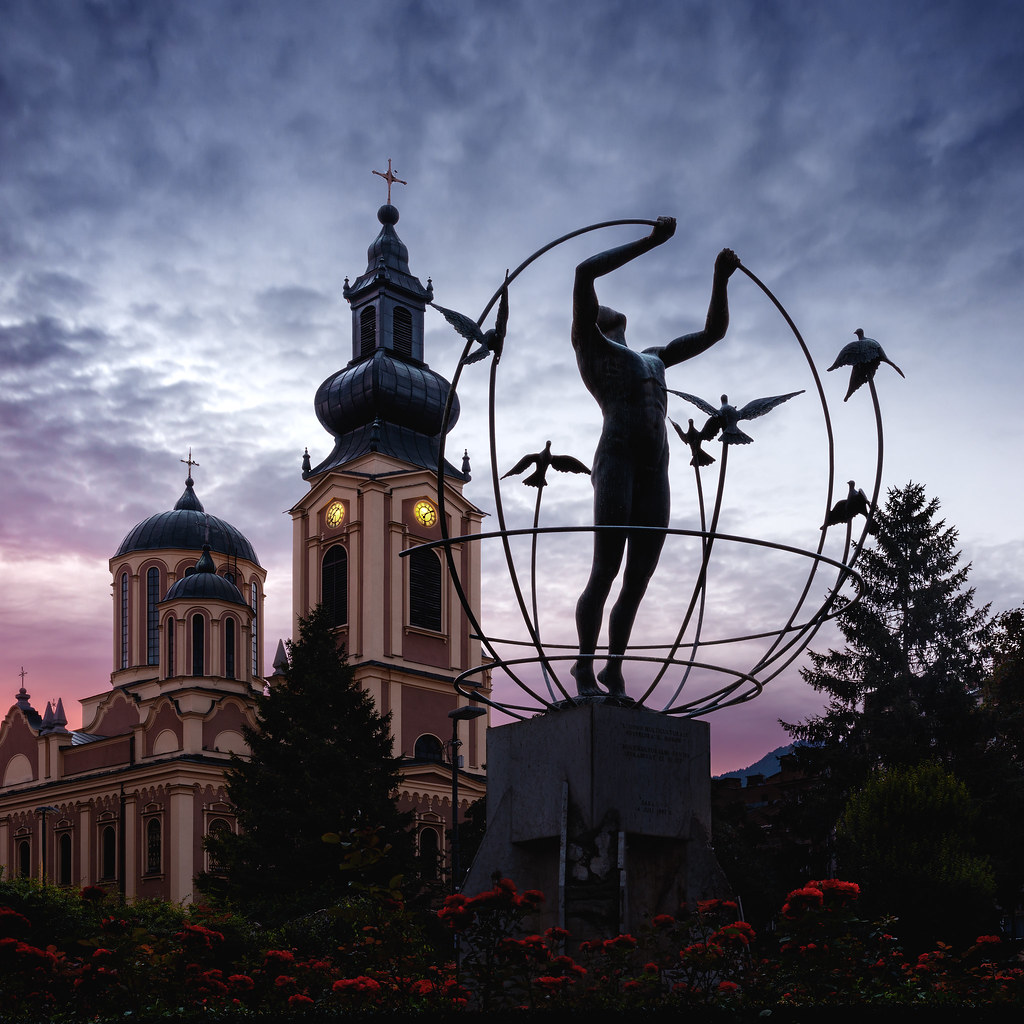
Cathedral Church of the Nativity of the Theotokos. Built in 1868, this is the largest Orthodox church in the Balkans. A lovely yellow/brown on the outside, it has a huge dome supported by 4 marble columns and an iconostasis donated by the Russian imperial family gilded with 69 icons made by Russian craftsmen. Damaged in the war, it was reconstructed in 1998-99. 2 BAM
Vraca. This high hillside community sits above SW Sarajevo. At the very top of the hill is the Vraca Memorial Park dedicated to the World War II victims in Sarajevo. It covers 78,000 square meters and mentions the names of over 11,000 men, women, and children killed during World War II. Built in 1981, it was opened on November 25, 1981, the “Day of Statehood of Bosnia and Herzegovina” in SR Bosnia & Herzegovina commemorating the date that ZAVNOBIH held their first meeting in 1943. In 1996, the park was systematically destroyed by withdrawing VRS forces after the signing of the Dayton Agreement. In 2005, the park was declared a National Monument of Bosnia and Herzegovina
At the bottom is a large eternal flame and a saying signed by Tito. Climb the stairs past grey granite blocks with 9091 names carved in bas-relief, all with death dates from 1941-45. At the very top is a polished granite cube surrounded by other names also dated 1941-45. Above that is a black stela with writing also signed by Tito in front of a white limestone “fort”.

This memorial commemorates the mass arrests and executions of B&H and especially Sarajevo citizens by the Italians, Austro-Hungarians and Germans in WWII. Much of the death toll occurred in concentration camps. Sarajevo was liberated in April 1943 and Germany signed the armistice on May 9, 1945, 3 days after WWII ended.
Goat’s Bridge (Kozija Cupija). About 4 km east of Sarajevo, this is a wonderful stone bridge with a single large arch. It is beautifully preserved. Iron bars connect the stones that form the low walls on the sides. It appears Roman. The sign next to the bridge was completely illegible. There are four spotlights and I assume it is lit up at night. Free

I needed groceries and finding a reasonable-sized supermarket was hard enough, but the selection here was interesting – half was cleaning products and toiletries, ¼ was chips, candy and biscuits, and ¼ was processed, but actual food. The tiny vegetable/fruit department had only stale stuff. When looking for the multicultural man, I passed the market again and stocked up with salad makings. I have a great salad every night for dinner.
After Goat Bridge, I headed to the Goražde area, with plans on continuing onto Srpska East (Bijeljina, Trebinje) to see some of the sights there. It took 1¼ hours to drive the 61 km to Goražde, a good road for half of it, then up and over a mountain. I descended onto Goražde from way above and had great views down to the town.
Canton Goražde. In the NM “XL” series – Bosnian-Podrinje Canton Goražde, this municipality is in the far southeast of the country. It is on the River, a large river that must be the largest in the country.
TUZLA
Museum of Eastern Bosnia. In an incredibly decrepit building with peeling paint, this museum appears to never be open.
International Portrait Gallery (Medunarodna Galerija Portreta). The permanent exhibitions consist of posters with vignettes of anti-fascist leaders from the past, 20 portraits of Tito – he commissioned artists from all over the country to paint him in 1947 and 1977 in a competition producing a mix of styles and times – quite interesting, and photographs of before and after the war in Tuzla. The temporary exhibition featured Hungarian artists: abstracts, nudes and a pizza parlour. Free
King Abdullah Bih Abdulah Aziz Ali Saud Mosque. This large, very modern mosque is white plaster on the outside and inside. The shallow dome is green with a large simple geometric and a cut-glass chandelier. The windows are clear glass, and the carpet is green with a unique geometric design.
TEŠANJ
Tešanj Castle and Old Town. This fortress on the hill in the middle of town was first mentioned in 1461 and taken by the Ottomans in 1520. They added the lower fort in 1697-1703. It was abandoned in 1820 and has had extensive reconstruction of the walls and two towers but there is little inside. The main reason to come is the views.
The only thing very old in the old town is the cobbled streets and narrow lanes in a small area to the north.

Tired of all the traffic and towns, I decided to take a more rural route to Banya Luka over a pass and along the Vrbanja River. After 4 days of cool, rainy weather, the river was almost in total flood with many trees usually on dry ground involved, fields and a few low-lying houses flooded. It was a tumultuous angry torrent of dirty brown water. The M4 was a good road with little traffic and few towns.
After Banya Luca, I drove south on M16 from Banya Luca up the spectacular canyon of the Vrbas River – narrow with steep limestone cliffs. It is multiply dammed and the reservoirs were a cesspool of floating plastic.
JAJCE The natural and architectural ensemble of Jajce. A tentative WHS (10/03/2006), The city sits surrounded by high hills on the banks of the Pliva River
Pliva Waterfall. After 4 days of rain, there was a huge amount of dirty brown water in the Pliva River in this wide cascade split by a tiny island with a precarious tree. It falls for another short cascade before joining the River coming in from the right. Walk down some stairs to a big concrete platform directly in front of the falls but you will get soaked from all the spray. A pedestrian bridge just upstream (covered in padlocks give access to the other side of the falls.
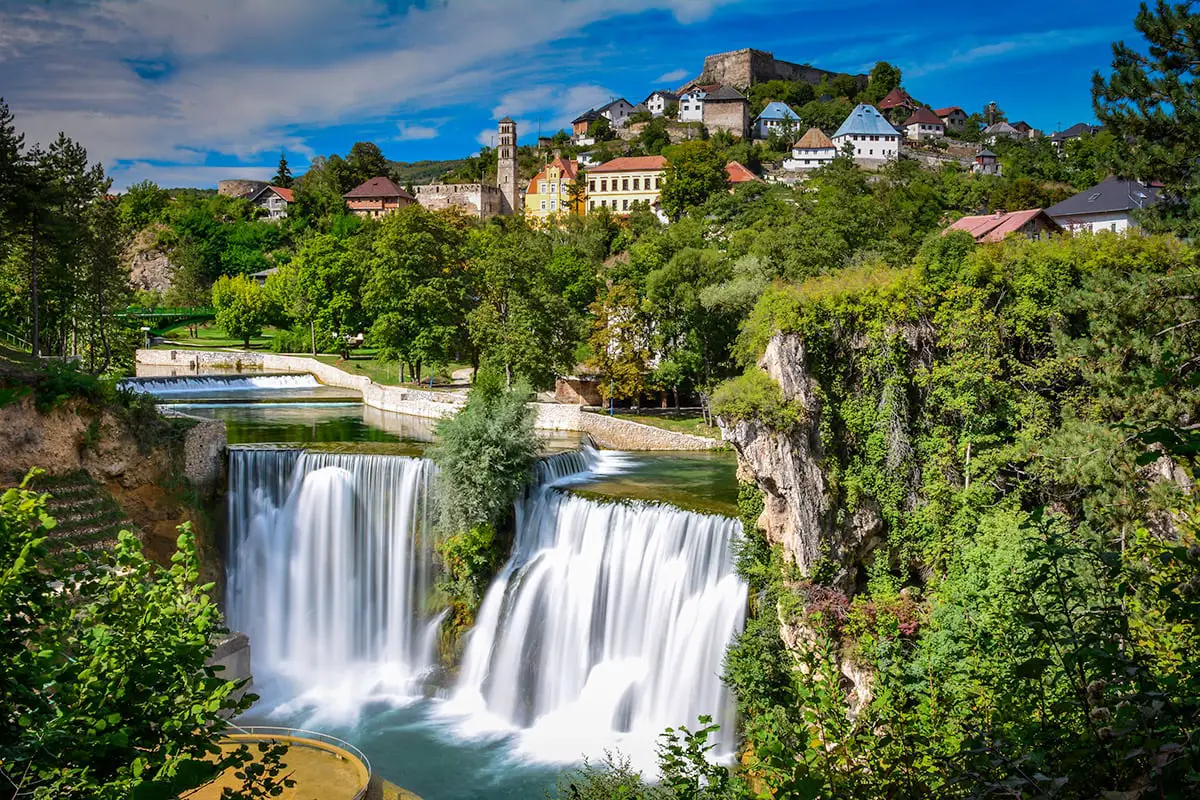
Jajce Castle. The castle sits on a hill in the middle of the town with a long, crenellated wall with towers snaking down to the river. With a relatively intact wall, there is little to see in the castle itself but the views down to the town are great.
AVNOJ Museum. Jajce was liberated in August 1943 and became the headquarters of the resistance movement. In November 1943, the second session of the AVNOJ (Antifascist Council of the National Liberation of Yugoslavia) was held in this building (the first council was in November 1942 in Bihać and the Communist Party of Yugoslavia was formed in early 1943 with Tito as its head). Delegates from all over Yugoslavia (except Macedonia and Sndzt) attended the council. They laid the foundations for a democratic Yugoslavia (incongruously by a communist party, odd how they usually put ‘democratic’ in their name). The large hall has a huge number of photos and documents presenting facts in a disorganized, repetitive way. A bust of Tito sits at the front of the stage. In the basement is a gallery of art and posters.
The country was liberated by November 1944 and the first cabinet of the Democratic Federation of Yugoslavia met on April 14, 1945. 4 BAM
From Jajce, I drove northwest reentering the Republic of Srpska just outside of town reentering at Sanski Most. The borders here make all the posts confusing as I entered and reentered the Federation of Bosnia multiple times.
Sanski Most Memorial (Susnjar Spomenik).
The massacre of Sanski Most (also called the massacre of Šušnjar) took place in August 1941. In the town of Sanski, approximately 5,500 Serb civilians and some 50 Jews were murdered by Ustaše forces and Bosnian Muslim militias. In addition, there were mass rapes of women and girls instead.
The victims were buried in mass graves, many of which are on the Šušnjar Hill. Here is now the monument, which is highly neglected.
In a treed park is this very unusual memorial with no signs explaining it. Enter a brick arch gate with a black slab in Cyrillic and a Star of David. The path is bordered by hundreds of concrete blocks with metal labels most dated from 1941-44 (they are all overgrown and mossy). Pass a large concrete slab with a cross to see the odd large geometric construction of riveted metal panels. Some of the panels have been removed exposing a small chamber inside littered with garbage. The structure is surrounded by huge, horizontal, hollow cement columns supported on pedestals. The whole place is very neglected but the grass had been mowed.

It was then a long drive northwest across mountains on the R405 to join the M14 and follow the Una River through a nice limestone canyon.
Ostrožac Castle, Ostrožac. This was a medieval fort built in 1296 by the princes of Babonjiće of Blacj and conquered by the Ottomans led by Ferhad Pasha Soolović after 100 years of siege in 1571. It was controlled by the Besineivić family who enlarged it and built the large keep on the west end. In 1846, it was purchased by Count Lothar von Berks, then mayor of Bihać who added a neo-Gothic castle in 1900-02. Lothar died in 1919 and the family lived in it until 1932 when they moved to Slavonia. The plaque stated that they still used it as a summer residence, but that must have been some years ago.
Enter the large, intact fortress and pass a sculpture garden in a lovely big area of grass. From 1967-2008, the fort was the location of a sculpture colony with attendees from all over the world. There are 130, mostly abstract sculptures, some quite interesting. The large mansion must have been quite nice but now is a neglected ruin. Most of the floors between the two stories have been removed. There are several lovely rooms at the south end and a balcony that looks down to the Una River far below. It is a 4.2km drive up from the M14 highway. Free
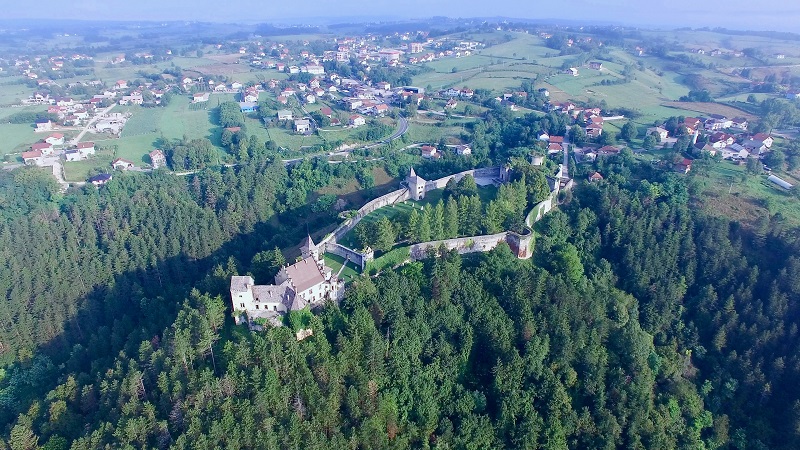

I then entered Croatia. Wanting to go to the Caves of Barać, I tried to cross the border just west along the M5 but it was closed so drove north and crossed west of Sturić. There were no issues at the border from either country.